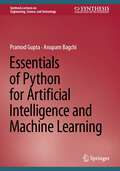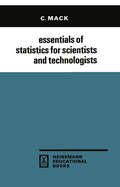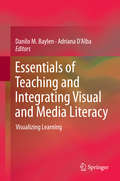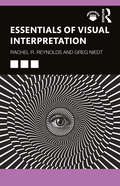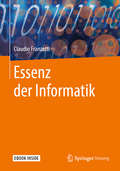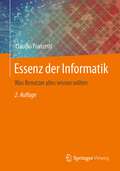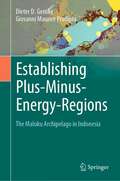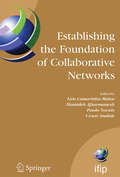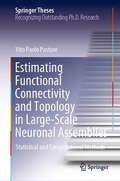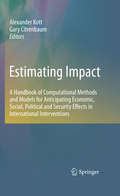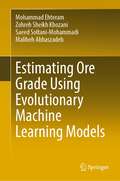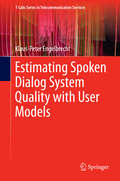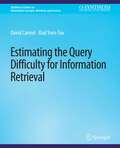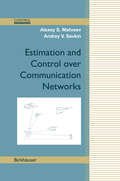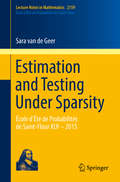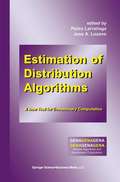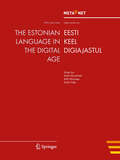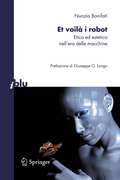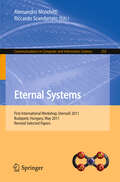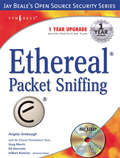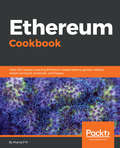- Table View
- List View
Essentials of Python for Artificial Intelligence and Machine Learning (Synthesis Lectures on Engineering, Science, and Technology)
by Pramod Gupta Anupam BagchiThis book introduces the essentials of Python for the emerging fields of Machine Learning (ML) and Artificial Intelligence (AI). The authors explore the use of Python’s advanced module features and apply them in probability, statistical testing, signal processing, financial forecasting, and various other applications. This includes mathematical operations with array data structures, Data Manipulation, Data Cleaning, machine learning, Data pipeline, probability density functions, interpolation, visualization, and other high-performance benefits using the core scientific packages NumPy, Pandas, SciPy, Sklearn/Scikit learn and Matplotlib. Readers will gain a deep understanding with problem-solving experience on these powerful platforms when dealing with engineering and scientific problems related to Machine Learning and Artificial Intelligence. Several examples of real problems using these techniques are provided along with examples. The authors also focus on the best practices in the industry on using Python for AI and ML. Deployment on a cloud infrastructure is described in detail (with code) to emphasize real scenarios.
Essentials of Statistics for Scientists and Technologists
by C. MackStatistics is of ever-increasing importance in Science and Technology and this book presents the essentials of the subject in a form suitable either as the basis of a course of lectures or to be read and/or used on its own. It assumes very little in the way of mathematical knowledge-just the ability to substitute numerically in a few simple formulae. However, some mathematical proofs are outlined or given in full to illustrate the derivation of the subject; these can be omitted without loss of understanding. The book does aim at making clear the scope and nature of those essential tests and methods that a scientist or technologist is likely to need; to this end each chapter has been divided into sections with their own subheadings and some effort has been made to make the text unambiguous (if any reader finds a misleading point anywhere I hope he will write to me about it). Also with this aim in view, the equality of probability to proportion of population is stated early, then the normal distribution and the taking of samples is discussed. This occupies the first five chapters. With the principles of these chapters understood, the student can immediately learn the significance tests of Chapter 6 and, if he needs it, the analysis of variance of Chapter 7. For some scientists this will be most of what they need. However, they will be in a position to read and/or use the remaining chapters without undue difficulty.
Essentials of Teaching and Integrating Visual and Media Literacy: Visualizing Learning
by Danilo M. Baylen Adriana D’AlbaThis book focuses on how to effectively integrate the teaching and learning of visual and media literacies in K-12 and higher education. Not only does it address and review the elements and principles of visual design but also identifies, discusses and describes the value of media in learning diverse and challenging content across disciplines. Finally, this book provides a balanced treatment of how visual and media literacies support deep content learning, student engagement, critical thinking, creativity, problem solving, and production.
Essentials of Visual Interpretation
by Rachel R Reynolds Greg NiedtEssentials of Visual Interpretation explains how to talk and write critically about visual media and to examine how evolving visual environments, media, and technologies affect human selfunderstanding and culture formation.Lively and accessibly written chapters provide a solid foundation in the tools and ideas of visual meaning, familiarizing readers with a growing, cross-cultural subfield, and preparing them to pursue thoughtful work in a variety of related disciplines. The authors include rich examples and illustrations—ranging from cave paintings to memes, from optical science to visual analytics, from ancient pictographs to smart phones—that engage students with the fascinating complexity of visual interpretation. Each chapter introduces students to key terms and concepts relevant to visual analysis, with ideas for short individual or group exercises to enhance understanding.The book is ideal as a primer in visual analysis and visual communication for students in courses within communication studies, cultural studies, digital humanities, semiotics, media studies, and visual anthropology.Online support materials include multimedia activities for students and links to additional resources for students and instructors.
Essentials of Visual Interpretation
by Rachel R Reynolds Greg NiedtEssentials of Visual Interpretation explains how to talk and write critically about visual media and to examine how evolving visual environments, media, and technologies affect human selfunderstanding and culture formation.Lively and accessibly written chapters provide a solid foundation in the tools and ideas of visual meaning, familiarizing readers with a growing, cross-cultural subfield, and preparing them to pursue thoughtful work in a variety of related disciplines. The authors include rich examples and illustrations—ranging from cave paintings to memes, from optical science to visual analytics, from ancient pictographs to smart phones—that engage students with the fascinating complexity of visual interpretation. Each chapter introduces students to key terms and concepts relevant to visual analysis, with ideas for short individual or group exercises to enhance understanding.The book is ideal as a primer in visual analysis and visual communication for students in courses within communication studies, cultural studies, digital humanities, semiotics, media studies, and visual anthropology.Online support materials include multimedia activities for students and links to additional resources for students and instructors.
Essenz der Informatik
by Claudio FranzettiMit diesem Buch meistern Sie die Grundlagen der InformatikDieses Buch beschreibt das weite Universum der Informatik und Informationstechnologie. Anhand von Endgeräten wie PC, Tablet und Smartphone sowie eingebetteten Systemen erklärt es die grundlegenden Prinzipien der Informatik und ihre soziale und gesellschaftspolitische Bedeutung. Das Buch richtet sich an alle regelmäßigen Benutzer von IT und insbesondere an Berufstätige, Schüler, Informatik-Studenten und Lehrer.Viele konkrete Beispiele, Illustrationen und Grafiken erklären die relevante IT-Umgebung und bringen Sie für alle interessierten IT-Laien in den richtigen Zusammenhang. Im Einzelnen widmet sich der Autor Bereichen wie: • Büroapplikationen• sozialen Medien• Spielen• HardwaretrendsVon der Geschichte der IT bis zum erfolgreichen Umgang mit Programmiersprachen – Die Inhalte im ÜberblickAlle Kapitel in diesem Buch schließen mit zehn Fragen zum Inhalt ab, die den Lesern eine Stütze zum gelesenen Inhalt geben und die Kompetenzen erweitern. Ein besonderes Highlight dieses Buches ist das Kapitel zur populären Programmiersprache Scratch, das die Grundlage für einen erfolgreichen Umgang mit dieser Programmiersprache legt. Des Weiteren beschäftigt sich der Autor mit den folgenden Themenschwerpunkten und Teilbereichen der Informatik:• Geschichte der IT• Computer als Hardware• Betriebssystem und Benutzeroberfläche• Information und Medien• Datenorganisation• Netzwerke• Programmierung und Softwareentwicklung• Applikationen• Sicherheit• IT-Organisation• Cloud-Computing• IT-Entwicklung• Digitalisierung und digitale Transformation• Künstliche Intelligenz• IT und Gesellschaft• Installation von ScratchInsgesamt vermittelt dieses Buch über die Informatik einen tiefgreifenden, breiten Überblick über verschiedene Thematiken der Informationstechnologie und ist damit nicht nur für Programmierer geeignet.
Essenz der Informatik: Was Benutzer alles wissen sollten
by Claudio FranzettiDiese erweiterte 2. Auflage richtet sich an die regelmäßigen Benutzer von IT, also Berufstätige sowie Schüler, Studierende und Lehrer. Das Buch beschreibt das relevante Universum der Informatik und der Informationstechnologie, von den grundlegenden Prinzipien bis zur sozialen und gesellschaftspolitischen Bedeutung.Neu und erweitert sind u. a. Themen zu virtuellen Welten, zum Metaversum, zu digitalen Zwillingen sowie zu Aspekten von Verwaltung und Digitalisierung. Anhand zahlreicher Beispiele sowie Illustrationen und Grafiken wird die relevante IT-Umgebung der modernen Nichtfachperson dargestellt. Büroapplikationen, soziale Medien, Spiele und Hardwaretrends sowie die verwendeten Devices werden erklärt und in Zusammenhang gebracht.In einem Kapitel werden die ersten Grundlagen zur Programmierung der sehr populären Blocksprache Scratch gelegt. Zu jedem Kapitel werden zehn Fragen zum Inhalt gestellt, um dem Leser oder der Leserin eine Stütze zum gelesenen Inhalt zu geben und die Kompetenzen zu erweitern.Der InhaltGanz kurze Geschichte der ITAlles ist ZahlComputer als HardwareBetriebssystem und BenutzeroberflächeNetzwerkeDatenorganisationIT-EntwicklungIT-OrganisationProgrammierungApplikationenCloud-ComputingSicherheitInformation und MedienKünstliche IntelligenzVirtuelle WeltenIT, Digitalisierung und Gesellschaft
Establishing Plus-Minus-Energy-Regions: The Maluku Archipelago in Indonesia
by Dieter D. Genske Giovanni Maurice PradiptaThis book explains and illustrates how Indonesia as the largest and most populous country in Southeast Asia can become independent of fossil fuels by both reducing its energy needs and using renewable resources. A study presented in this work focuses on the Maluku Archipelago in eastern Indonesia with Ambon as its capital. Conventional energy is brought to the islands over long distances by partly simple means as boats, ships and aircrafts. This unsustainable situation calls for a decentralized renewable energy supply strategy. Based on the research presented in this book, it is clear that the archipelago has the potential to become a so-called plus-minus region. Plus-minus regions are regions that produce more renewable energy than they need and capture more CO2 than they emit. The authors are convinced that the presented strategy illustrated on the Maluku Archipelago can be transferred to other regions of the world and that only by developing plus-minus regions the international 2°C climate goal can be achieved. The model region thus serves as proof that the plus-minus target can also be achieved in emerging countries with limited financial resources.
Establishing the Foundation of Collaborative Networks: IFIP TC 5 Working Group 5.5 Eighth IFIP Working Conference on Virtual Enterprises September 10-12, 2007, Guimarães, Portugal (IFIP Advances in Information and Communication Technology #243)
by Luis Camarinha-Matos Hamideh Afsarmanesh Paulo Novais Cesar AnalideThis book includes a number of selected papers from the PRO-VE '07 Conference, providing a comprehensive overview of recent advances in various Collaborative Networks domains. It covers trust aspects, performance and value systems, VO breeding environments, VO creation, e-contracting, collaborative architectures and frameworks, professional virtual communities, interoperability issues, business benefits, and case studies and applications in industry and services.
Estelle, LOTOS und SDL: Standard-Spezifikationssprachen für verteilte Systeme (Springer Compass)
by Dieter HogrefeDas Buch gibt eine Einführung in die Spezifikationssprachen Estelle, LOTOS und SDL. Die Sprachen sind Standardsprachen der ISO (Estelle, LOTOS) und des CCITT (SDL) zur Spezifikation von Diensten und Protokollen in Kommunikationssystemen. Insbesondere im Zusammenhang mit der Idee und den Konzepten von OSI (Open Systems Interconnection) gewinnen die drei Sprachen zunehmend an Bedeutung - innerhalb und außerhalb der Normung. Das Buch stellt die drei Sprachen weitgehend anhand von durchgängigen Beispielen vor, bei denen es sich um Dienste und Protokolle handelt, die den OSI-Konzepten folgen. Das Besondere an dem Buch ist, daß durch die Verwendung identischer Beispiele die drei Sprachen direkt miteinander vergleichbar werden. Obwohl Estelle, LOTOS und SDL formale Sprachen sind, wird weitgehend auf Formalismen verzichtet, so daß die Darstellung allgemein und leicht verständlich ist. Das Buch bildet daher ein sehr nützliches Komplement zu den offiziellen Dokumenten und Sprachbeschreibungen der ISO und des CCITT. Das Ziel des Buches ist, dem Leser einen Einblick in die drei Sprachen zu geben und als leicht verständliches und kompaktes Nachschlagewerk in der täglichen Arbeit zu dienen.
Estimating Functional Connectivity and Topology in Large-Scale Neuronal Assemblies: Statistical and Computational Methods (Springer Theses)
by Vito Paolo PastoreThis book describes a set of novel statistical algorithms designed to infer functional connectivity of large-scale neural assemblies. The algorithms are developed with the aim of maximizing computational accuracy and efficiency, while faithfully reconstructing both the inhibitory and excitatory functional links. The book reports on statistical methods to compute the most significant functional connectivity graph, and shows how to use graph theory to extract the topological features of the computed network. A particular feature is that the methods used and extended at the purpose of this work are reported in a fairly completed, yet concise manner, together with the necessary mathematical fundamentals and explanations to understand their application. Furthermore, all these methods have been embedded in the user-friendly open source software named SpiCoDyn, which is also introduced here. All in all, this book provides researchers and graduate students in bioengineering, neurophysiology and computer science, with a set of simplified and reduced models for studying functional connectivity in in silico biological neuronal networks, thus overcoming the complexity of brain circuits.
Estimating Impact: A Handbook of Computational Methods and Models for Anticipating Economic, Social, Political and Security Effects in International Interventions
by Alexander Kott Gary CitrenbaumSociological theories of crime include: theories of strain blame crime on personal stressors; theories of social learning blame crime on its social rewards, and see crime more as an institution in conflict with other institutions rather than as in- vidual deviance; and theories of control look at crime as natural and rewarding, and explore the formation of institutions that control crime. Theorists of corruption generally agree that corruption is an expression of the Patron–Client relationship in which a person with access to resources trades resources with kin and members of the community in exchange for loyalty. Some approaches to modeling crime and corruption do not involve an explicit simulation: rule based systems; Bayesian networks; game theoretic approaches, often based on rational choice theory; and Neoclassical Econometrics, a rational choice-based approach. Simulation-based approaches take into account greater complexities of interacting parts of social phenomena. These include fuzzy cognitive maps and fuzzy rule sets that may incorporate feedback; and agent-based simulation, which can go a step farther by computing new social structures not previously identified in theory. The latter include cognitive agent models, in which agents learn how to perceive their en- ronment and act upon the perceptions of their individual experiences; and reactive agent simulation, which, while less capable than cognitive-agent simulation, is adequate for testing a policy’s effects with existing societal structures. For example, NNL is a cognitive agent model based on the REPAST Simphony toolkit.
Estimating Ore Grade Using Evolutionary Machine Learning Models
by Mohammad Ehteram Zohreh Sheikh Khozani Saeed Soltani-Mohammadi Maliheh AbbaszadehThis book examines the abilities of new machine learning models for predicting ore grade in mining engineering. A variety of case studies are examined in this book. A motivation for preparing this book was the absence of robust models for estimating ore grade. Models of current books can also be used for the different sciences because they have high capabilities for estimating different variables. Mining engineers can use the book to determine the ore grade accurately. This book helps identify mineral-rich regions for exploration and exploitation. Exploration costs can be decreased by using the models in the current book. In this book, the author discusses the new concepts in mining engineering, such as uncertainty in ore grade modeling. Ensemble models are presented in this book to estimate ore grade. In the book, readers learn how to construct advanced machine learning models for estimating ore grade. The authors of this book present advanced and hybrid models used to estimate ore grade instead of the classic methods such as kriging. The current book can be used as a comprehensive handbook for estimating ore grades. Industrial managers and modelers can use the models of the current books. Each level of ore grade modeling is explained in the book. In this book, advanced optimizers are presented to train machine learning models. Therefore, the book can also be used by modelers in other fields. The main motivation of this book is to address previous shortcomings in the modeling process of ore grades. The scope of this book includes mining engineering, soft computing models, and artificial intelligence.
Estimating Spoken Dialog System Quality with User Models (T-Labs Series in Telecommunication Services)
by Klaus-Peter EngelbrechtSpoken dialog systems have the potential to offer highly intuitive user interfaces, as they allow systems to be controlled using natural language. However, the complexity inherent in natural language dialogs means that careful testing of the system must be carried out from the very beginning of the design process. This book examines how user models can be used to support such early evaluations in two ways: by running simulations of dialogs, and by estimating the quality judgments of users. First, a design environment supporting the creation of dialog flows, the simulation of dialogs, and the analysis of the simulated data is proposed. How the quality of user simulations may be quantified with respect to their suitability for both formative and summative evaluation is then discussed. The remainder of the book is dedicated to the problem of predicting quality judgments of users based on interaction data. New modeling approaches are presented, which process the dialogs as sequences, and which allow knowledge about the judgment behavior of users to be incorporated into predictions. All proposed methods are validated with example evaluation studies.
Estimating the Query Difficulty for Information Retrieval (Synthesis Lectures on Information Concepts, Retrieval, and Services)
by David Carmel Elad Yom-TovMany information retrieval (IR) systems suffer from a radical variance in performance when responding to users' queries. Even for systems that succeed very well on average, the quality of results returned for some of the queries is poor. Thus, it is desirable that IR systems will be able to identify "difficult" queries so they can be handled properly. Understanding why some queries are inherently more difficult than others is essential for IR, and a good answer to this important question will help search engines to reduce the variance in performance, hence better servicing their customer needs. Estimating the query difficulty is an attempt to quantify the quality of search results retrieved for a query from a given collection of documents. This book discusses the reasons that cause search engines to fail for some of the queries, and then reviews recent approaches for estimating query difficulty in the IR field. It then describes a common methodology for evaluating the prediction quality of those estimators, and experiments with some of the predictors applied by various IR methods over several TREC benchmarks. Finally, it discusses potential applications that can utilize query difficulty estimators by handling each query individually and selectively, based upon its estimated difficulty. Table of Contents: Introduction - The Robustness Problem of Information Retrieval / Basic Concepts / Query Performance Prediction Methods / Pre-Retrieval Prediction Methods / Post-Retrieval Prediction Methods / Combining Predictors / A General Model for Query Difficulty / Applications of Query Difficulty Estimation / Summary and Conclusions
Estimation and Control over Communication Networks (Control Engineering)
by Alexey S. Matveev Andrey V. SavkinThis book presents a systematic theory of estimation and control over communication networks. It develops a theory that utilizes communications, control, information and dynamical systems theory motivated and applied to advanced networking scenarios. The book establishes theoretically rich and practically important connections among modern control theory, Shannon information theory, and entropy theory of dynamical systems originated in the work of Kolmogorov. This self-contained monograph covers the latest achievements in the area. It contains many real-world applications and the presentation is accessible.
Estimation and Testing Under Sparsity: École d'Été de Probabilités de Saint-Flour XLV – 2015 (Lecture Notes in Mathematics #2159)
by Sara van de GeerTaking the Lasso method as its starting point, this book describes the main ingredients needed to study general loss functions and sparsity-inducing regularizers. It also provides a semi-parametric approach to establishing confidence intervals and tests. Sparsity-inducing methods have proven to be very useful in the analysis of high-dimensional data. Examples include the Lasso and group Lasso methods, and the least squares method with other norm-penalties, such as the nuclear norm. The illustrations provided include generalized linear models, density estimation, matrix completion and sparse principal components. Each chapter ends with a problem section. The book can be used as a textbook for a graduate or PhD course.
Estimation of Distribution Algorithms: A New Tool for Evolutionary Computation (Genetic Algorithms and Evolutionary Computation #2)
by Pedro Larrañaga José A. LozanoEstimation of Distribution Algorithms: A New Tool for Evolutionary Computation is devoted to a new paradigm for evolutionary computation, named estimation of distribution algorithms (EDAs). This new class of algorithms generalizes genetic algorithms by replacing the crossover and mutation operators with learning and sampling from the probability distribution of the best individuals of the population at each iteration of the algorithm. Working in such a way, the relationships between the variables involved in the problem domain are explicitly and effectively captured and exploited. This text constitutes the first compilation and review of the techniques and applications of this new tool for performing evolutionary computation. Estimation of Distribution Algorithms: A New Tool for Evolutionary Computation is clearly divided into three parts. Part I is dedicated to the foundations of EDAs. In this part, after introducing some probabilistic graphical models - Bayesian and Gaussian networks - a review of existing EDA approaches is presented, as well as some new methods based on more flexible probabilistic graphical models. A mathematical modeling of discrete EDAs is also presented. Part II covers several applications of EDAs in some classical optimization problems: the travelling salesman problem, the job scheduling problem, and the knapsack problem. EDAs are also applied to the optimization of some well-known combinatorial and continuous functions. Part III presents the application of EDAs to solve some problems that arise in the machine learning field: feature subset selection, feature weighting in K-NN classifiers, rule induction, partial abductive inference in Bayesian networks, partitional clustering, and the search for optimal weights in artificial neural networks. Estimation of Distribution Algorithms: A New Tool for Evolutionary Computation is a useful and interesting tool for researchers working in the field of evolutionary computation and for engineers who face real-world optimization problems. This book may also be used by graduate students and researchers in computer science. `... I urge those who are interested in EDAs to study this well-crafted book today.' David E. Goldberg, University of Illinois Champaign-Urbana.
The Estonian Language in the Digital Age (White Paper Series)
by Georg Rehm Hans UszkoreitThis white paper is part of a series that promotes knowledge about language technology and its potential. It addresses educators, journalists, politicians, language communities and others. The availability and use of language technology in Europe varies between languages. Consequently, the actions that are required to further support research and development of language technologies also differ for each language. The required actions depend on many factors, such as the complexity of a given language and the size of its community. META-NET, a Network of Excellence funded by the European Commission, has conducted an analysis of current language resources and technologies. This analysis focused on the 23 official European languages as well as other important national and regional languages in Europe. The results of this analysis suggest that there are many significant research gaps for each language. A more detailed expert analysis and assessment of the current situation will help maximise the impact of additional research and minimize any risks. META-NET consists of 54 research centres from 33 countries that are working with stakeholders from commercial businesses, government agencies, industry, research organisations, software companies, technology providers and European universities. Together, they are creating a common technology vision while developing a strategic research agenda that shows how language technology applications can address any research gaps by 2020.
Et al.: Because not all research deserves a Nobel Prize
by B McGrawEt al. is a satirical academic journal that uses machine learning and scientific principles on absurd studies, from the cat Lord Whiskers' role in the extinction of the dodo bird to the quantum mysteries of untidy toddler rooms.Key FeaturesConducts satirical research on topics ranging from quantum computing to clingy robot dog algorithmsAnswers questions like “Can a computer understand a Scotsman?” and “Is Sarah Palin real?”Secures the power grid and your home from the prying eyes of government drones a.k.a. birdsExpands science by studying cow-based atmospheres, and the flavortown center of the brainSolves climate change and saves the world by proposing a banana-based fission reactorNullifies the possibility of getting lost at the fair with a mirror-house escape algorithmBook DescriptionTired of the same old math, science, statistics, and programming memes people post online and want something a little more elaborate? This is the book for you. Tremble as we make up all our own facts and data, hand-draw diagrams in MS Paint, and quote from fictional studies and journals. Cower as authors write in the first person because their study is just a little too personal for them. Recoil from the sheer mass of oversimplified methodology, distilling someone's entire thesis into a paragraph of jokes crude enough to make it into a Mike Myers movie. Over the last few years, we have taken arguments that you would normally have after four Jack and cokes at game night and turned them into properly formatted research papers with a writing tone serious enough to confuse the uninitiated. These papers are high-effort jokes by researchers and scientists for researchers and scientists. They cover a range of topics such as the consequences of re-releasing tourists back into Yellowstone National Park after COVID-19, how to play StarCraft competitively online on a quantum computer, and most importantly, how trees around the globe are becoming increasingly radicalized.What you will learnHow to draw a graph using MS Paint, maybeWhether Sarah Palin is a figment of your imaginationHow one pirate cat brought about the extinction of the beloved dodoWhy rabbits used to be jerks back in the dayIf you actually learn anything from these articles, get your memory erased immediatelyWho this book is forThis book is for researchers and those who love science mingled with humor. It's for those who are a little too tired of the talking heads and futurists of the science world and would like something more entertaining in the form of absurd speculative studies by researchers as unbelievable as their work. Anyone who has experienced academic writing, or the tribulations of any research institution will enjoy the wide range of bizarre, yet real-world topics compiled in this book. Even if you don't know much about the subject, we usually have a background section.
Et voilà i robot: Etica ed estetica nell'era delle macchine (I blu)
by Nunzia BonifatiI robot. Ci somigliano e come noi sanno imparare dall’esperienza, decidere in modo autonomo, muoversi in libertà, comunicare con il linguaggio e con la mimica. Presto li useremo come estensioni del nostro corpo, per migliorarci e renderci più sani e forti. E forse, domani, saranno simili agli organismi viventi. Dal Golem a Terminator, è dalla notte dei tempi che l’umanità sogna queste creature immortalandole in figure di eroi salvifici o di mostri temibili nel mito, nella letteratura, nel cinema. E oggi questi figli dell’immaginazione e della conoscenza, questi simboli del legame inscindibile tra uomo e tecnologia approdano dal regno della fantasia alla realtà quotidiana, inaugurando quella che per gli esperti sarà l’era dei robot. Siamo pronti al loro debutto in società? Riusciremo a convivere con queste macchine senza divenirne schiavi? Sapremo farne un uso pacifico, per il bene dell’umanità e dei robot stessi?
Eternal Systems: First International Workshop, EternalS 2011, Budapest, Hungary, May 3, 2011, Revised Selected Papers (Communications in Computer and Information Science #255)
by Alessandro Moschitti Riccardo ScandariatoThis book constitutes the refereed post-proceedings of the First International Workshop on Eternal Systems, EternalS 2011, held in Budapest, Hungary, in May 2011. The workshop aimed at creating the conditions for mutual awareness and cross-fertilization among broad ICT areas such as learning systems for knowledge management and representation, software systems, networked systems and secure systems, by focusing on their shared objectives such as adaptation, evolvability and flexibility for the development of long living and versatile systems. The 6 revised full papers and 4 short papers presented were carefully reviewed and selected from 15 submissions. They are organized in topical sections on software and secure systems, machine learning for software systems, and ontology and knowledge representations.
Ethereal Packet Sniffing
by SyngressThis book provides system administrators with all of the information as well as software they need to run Ethereal Protocol Analyzer on their networks. There are currently no other books published on Ethereal, so this book will begin with chapters covering the installation and configuration of Ethereal. From there the book quickly moves into more advanced topics such as optimizing Ethereal's performance and analyzing data output by Ethereal. Ethereal is an extremely powerful and complex product, capable of analyzing over 350 different network protocols. As such, this book also provides readers with an overview of the most common network protocols used, as well as analysis of Ethereal reports on the various protocols. The last part of the book provides readers with advanced information on using reports generated by Ethereal to both fix security holes and optimize network performance.Provides insider information on how to optimize performance of Ethereal on enterprise networks.Book comes with a CD containing Ethereal, Tethereal, Nessus, Snort, ACID, Barnyard, and more!Includes coverage of popular command-line version, Tethereal.
Ethereum Cookbook: Over 100 recipes covering Ethereum-based tokens, games, wallets, smart contracts, protocols, and Dapps
by Manoj P RMine Ether, deploy smart contracts, tokens, and ICOs, and manage security vulnerabilities of Ethereum Key Features Build end-to-end decentralized Ethereum apps using Truffle, Web3, and Solidity Explore various solution-based recipes to build smart contracts and foolproof decentralized applications Develop decentralized marketplaces from scratch, build wallets, and manage transactions Book Description Ethereum and Blockchain will change the way software is built for business transactions. Most industries have been looking to leverage these new technologies to gain efficiencies and create new business models and opportunities. The Ethereum Cookbook covers various solutions such as setting up Ethereum, writing smart contracts, and creating tokens, among others. You'll learn about the security vulnerabilities, along with other protocols of Ethereum. Once you have understood the basics, you'll move on to exploring various design decisions and tips to make your application scalable and secure. In addition to this, you'll work with various Ethereum packages such as Truffle, Web3, and Ganache. By the end of this book, you'll have comprehensively grasped the Ethereum principles and ecosystem. What you will learn Efficiently write smart contracts in Ethereum Build scalable distributed applications and deploy them Use tools and frameworks to develop, deploy, and test your application Use block explorers such as Etherscan to find a specific transaction Create your own tokens, initial coin offerings (ICOs), and games Understand various security flaws in smart contracts in order to avoid them Who this book is for The Ethereum Cookbook is for you if you are a software engineer, Blockchain developer, or research scientist who wants to build smart contracts, develop decentralized applications, and facilitate peer-to-peer transaction. It is assumed that you are familiar with Blockchain concepts and have sound knowledge of JavaScript.
Ethereum Cookbook: Over 100 recipes covering Ethereum-based tokens, games, wallets, smart contracts, protocols, and Dapps
by Manoj P RMine Ether, deploy smart contracts, tokens, and ICOs, and manage security vulnerabilities of Ethereum Key Features Build end-to-end decentralized Ethereum apps using Truffle, Web3, and Solidity Explore various solution-based recipes to build smart contracts and foolproof decentralized applications Develop decentralized marketplaces from scratch, build wallets, and manage transactions Book Description Ethereum and Blockchain will change the way software is built for business transactions. Most industries have been looking to leverage these new technologies to gain efficiencies and create new business models and opportunities. The Ethereum Cookbook covers various solutions such as setting up Ethereum, writing smart contracts, and creating tokens, among others. You'll learn about the security vulnerabilities, along with other protocols of Ethereum. Once you have understood the basics, you'll move on to exploring various design decisions and tips to make your application scalable and secure. In addition to this, you'll work with various Ethereum packages such as Truffle, Web3, and Ganache. By the end of this book, you'll have comprehensively grasped the Ethereum principles and ecosystem. What you will learn Efficiently write smart contracts in Ethereum Build scalable distributed applications and deploy them Use tools and frameworks to develop, deploy, and test your application Use block explorers such as Etherscan to find a specific transaction Create your own tokens, initial coin offerings (ICOs), and games Understand various security flaws in smart contracts in order to avoid them Who this book is for The Ethereum Cookbook is for you if you are a software engineer, Blockchain developer, or research scientist who wants to build smart contracts, develop decentralized applications, and facilitate peer-to-peer transaction. It is assumed that you are familiar with Blockchain concepts and have sound knowledge of JavaScript.
